|
HAGI-OGRAPHY
Desperately Seeking Kyusetsu
By ROBERT YELLIN
for The Japan Times, December 10, 2003
This page includes 30 photos

Miwa Kyusetsu XII
In the world of tea, certain inherited potters' names stand out as shining stars and their works are seen almost as brand-name goods. Just as shoppers hanker for a Gucci bag, a tea devotee covets certain chawan (tea bowls), say, from the Kaneshige kiln in Bizen. Possessing one of these is a status symbol, seeming to confer instant credibility on its owner as one who "understands" tea.
|
|
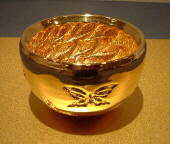
Golden chawan
by Miwa Kyusetsu XII
|
|
|
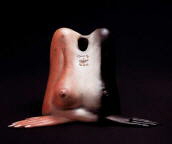
The "Maria" by Ryosaku
before becoming Kyusetsu XII
|
|
|
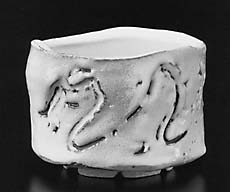
Dragon Chawan by Ryosaku
before becoming Kyusetsu XII
|
|
|
|
|
You may have heard the old adage of the hierarchical tea world -- "Raku first, Hagi second, Karatsu third" -- ranking the most esteemed styles of chawan. For Raku, the name that reigns supreme is Raku Kichizaemon (now in the 15th generation); in Hagi it's Miwa Kyusetsu; and in Karatsu it's Nakazato Taroemon (now in the 14th generation).
The 12th-generation Kyusetsu assumed his title this year and offered up some very unorthodox "Hagi" chawan at recent exhibitions in Osaka, Kyoto, and Tokyo. I place Hagi in apostrophes, as I don't think his chawan qualifies for the name. Lamentably, Kyusetsu Miwa XII has broken the noble traditions of his line.
The Miwa family is one of the most important potting families in all of Japan. Their kiln was established in Kanbun 3 (1663) in the Matsumoto area of Hagi (in Yamaguchi Prefecture on the Sea of Japan coast) in order to produce tea utensils for Lord Mori Terumoto. The successive generations of Miwa potters have produced all sorts of works besides tea ware, including Raku ware (Kyusetsu I and IV studied in Kyoto), figurines of mythical creatures (Kyusetsu VI and VII), and vessels for the table.
In the 1930s, when there was a "Return to Momoyama" revival (the Way of Tea was crystallized in the Momoyama Period, 1573-1615), Miwa Kyuwa (Kyusetsu X) revitalized the Hagi tea world with his warm and sensuous chawan and other tea utensils, while his younger brother Miwa Jusetsu (Kyusetsu XI) added power and strength with his Oni-Hagi (devil-Hagi) chawan. The brothers were named as Living National Treasures for their Hagi wares in 1970 and 1983, respectively.
Jusetsu's eldest son is Ryosaku, 63, who is now known as Kyusetsu XII because his father passed on the honor to him in April this year (2003).
|
|
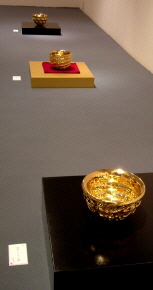
Exhibition Scene
|
|
|
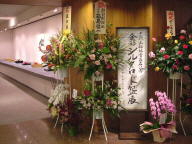
Gallery Entrance
|
|
|
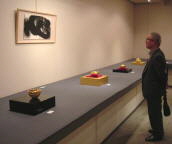
Exhibition Scene
|
|
|

Exhibition Pieces
|
|
|
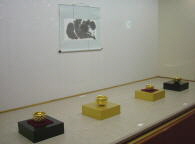
Exhibition Scene
|
|
|
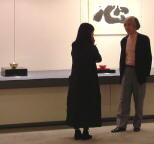
Miwa talking with fan
|
|
|
Above photos by Robert Yellin
|
|
|
|
|
Most first-born sons of famous potters are under tremendous pressure to follow directly (or as closely as possible) in their father's footsteps. Yet the motto of Kyusetsu XII has always been that "the important thing is to find a new path." He has found one -- and it is far off the beaten "Way."
Kyusetsu XII has always been provocative. He first shocked the ceramic art world with his "High Heel" series in 1966. These life-size ceramic shoes were more pop art than Hagi. Indeed, coming from a master of Hagi, a style devoted to tea ware, they were nothing short of heretical.
He didn't stop there. He went on to create "Hagi" ware sculptural works that included dripping "volcanoes of love"; Cyclops; spread female legs with everything in between; chickens; and, in 2001, a series of voluptuous women's breasts. The man has always had Eros on his mind: A heart is seen streaking across many of his creations. (See photo tour at bottom of page for various pieces mentioned above).
True, each work does have a philosophical background to it -- the breasts, for example, formed a series named "Mariya," a combination of Maya, the mother of Buddha, and Maria, the mother of Christ. Yet though the idea behind a work may be lofty, if the concept is flaunted pompously, the work often fails.
This is exactly what is evident in Ryosaku's current "Silk Road" series of golden chawan, his debut works as Kyusetsu XII.
The Silk Road connection comes by way of a chawan Miwa saw in the Shoso-in (Imperial Repository) collection in Nara 20 years ago. The result is a number of flashy and uninviting chawan from a man who has just inherited the "earthy" Kyusetsu name. So my big question to Miwa is this: Why did he take on the hallowed Hagi name if he wanted to continue on his own, non-Hagi way?
No doubt the artfulness, technique and vision embodied in the golden chawan are commendable. You can't help but admire the intricate designs, perfect shapes and brilliant sheen on each bowl -- the man is a virtuoso.
Yet these chawan are more for display than actual use. A few of the gilded bowls gave the appearance of being user-friendly, with their smooth mikomi (pools in the bottom of the bowl). Yet many had lumpy, meshed "pools" that were hardly suited for whipped green tea. Additionally -- and more importantly -- there was not one speck of any Hagi-ness: no soft and warm glazes; no fine tsuchi aji (clay flavor); no feeling of hin (grace). In short: zilch.
One viewer from Italy who saw the works wrote to me, "I hope that one day the gold coating will break and the clay and spirit of Hagi comes to the surface again!"
Kyusetsu XII is, beyond a shadow of a doubt, more than capable of making true Hagi chawan that are radical, bold and provocative -- as he did a few years back with his Hagi "dragon chawan." When we met at the Tokyo exhibition, he told me he doesn't know what he's going to make next. Oh, the thought of it! May the voices of his ancestors haunt him in his dreams and inspire him to return to the "path" that is meant for the artist who bears the name Kyusetsu. True Hagi chawan are part of the backbone of Japanese culture, and many exalted dreams are found within their clay walls.
As another Italian viewer wrote to me, "I think that a Hagi chawan covered in gold loses the spirituality that is inherent in Hagi." Kyusetsu XII should ponder that -- or change his name back to Ryosaku.
The Japan Times: Dec. 10, 2003
(C) All rights reserved

ADDITIONAL EXHIBITION PHOTOS
WORK BY MIWA KYUSETSU XII (formerly Ryosaku)
|
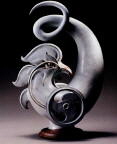
Chicken by Ryosaku
|
|
|
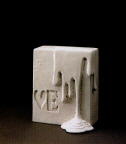
Volcano of Love by Ryosaku
|
|
|
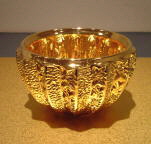
Silk Road Chawan
|
|
|

Chawan
|
|
|
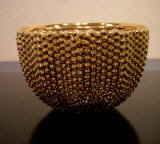
Chawan
|
|
|

Side View of Chawan
|
|
|
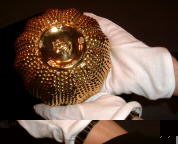
Kodai (foot) of Chawan
|
|
|
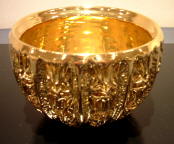
Chawan
|
|
|
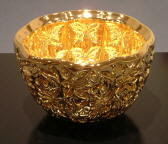
Chawan
|
|
|
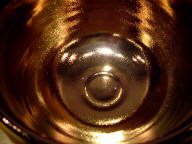
Inside View of Chawan
|
|
|

Chawan
|
|
|
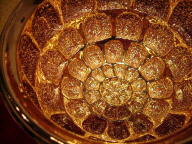
Inside View of Chawan
|
|
|

Chawan
|
|
|
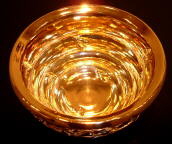
Inside View of Chawan
|
|
|
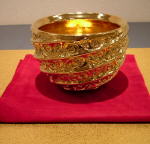
Chawan
|
|
|

Inside View of Chawan
|
|
|
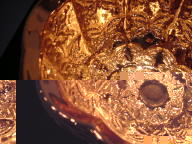
Inside view of another chawan
|
|
|

Inside view of another chawan
|
|
|
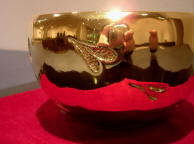
Side of Chawan
|
|
|
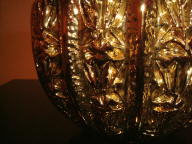
Side of Chawan
|
|
|
LEARN MORE ABOUT THIS CERAMIC FAMILY

|